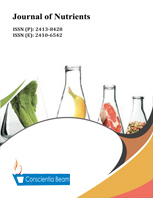The Effect of Regular Hazelnut Consumption on Cardiovascular Risk Factors and Acceptance in Māori and European
DOI:
https://doi.org/10.18488/journal.87/2015.2.2/87.2.39.53Abstract
Aims Studies reporting reductions in heart disease risk with regular nut consumption comprise populations largely of European descent. Whether the healthful effects of nuts extend to other ethnic groups is largely unknown. This study compared the effects of consuming 30 g/d of hazelnuts on risk factors for cardiovascular disease (CVD) and acceptance amongst Māori and Europeans. Methods Twenty Māori and 19 European participants consumed 30 g/d of hazelnuts for 28 days. Plasma lipids and lipoproteins, apolipoproteins (apo), high sensitivity C-reactive protein (hs-CRP), blood pressure, dietary intake, and body weight were measured at baseline and at the end of the intervention. ‘Desire to consume’ and ‘overall liking’ for hazelnuts were assessed daily. Results There were no significant differences in the changes of any of the outcome measurements between Māori and Europeans (P≥0.145). Further, there were no significant changes among participants overall in biochemical indices, blood pressure, body weight, BMI, or body composition (P≥0.114) aside from systolic blood pressure which decreased by 3% (P=0.031) and hs-CRP which increased by 0.21 mg/dl (P=0.047) during the study. However, the hazelnut-enriched diet significantly increased energy, total fat, monounsaturated and polyunsaturated fat intake in study participants (all P≤0.006), with no changes for other nutrients (all P≥0.116) or difference between groups (all P≥0.513). ‘Desire to consume’ and ‘overall liking’ remained relatively stable over the 28-day intervention period. Conclusions There was no evidence of difference in effects on CVD risk factors between Māori and European following regular consumption of nuts. It appears both ethnic groups continued to like nuts and wished to consume them daily after consuming nuts for 28-days, suggesting adherence to guidelines to consume nuts regularly is achievable in both populations.

